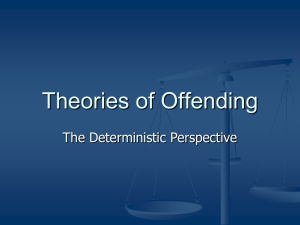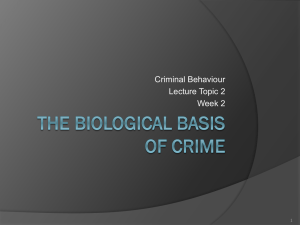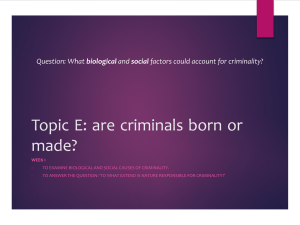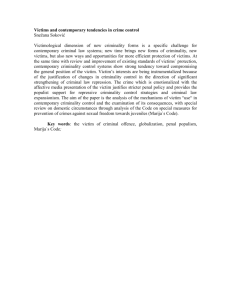Physiological theories of offending
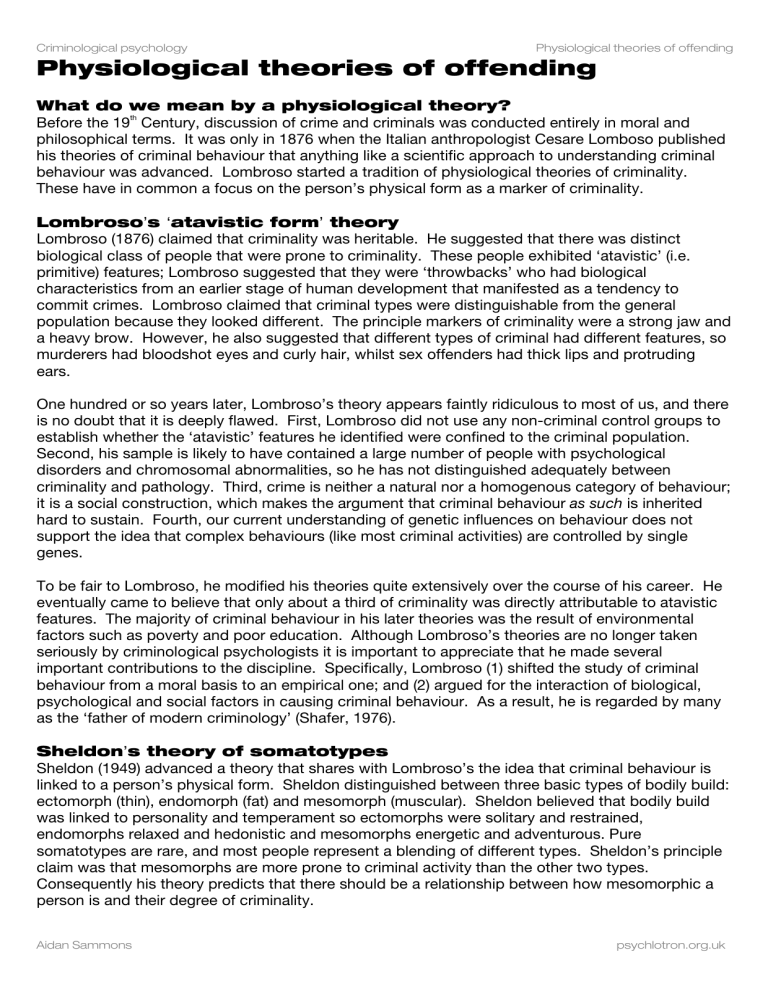
Criminological psychology Physiological theories of offending
Physiological theories of offending
What do we mean by a physiological theory?
Before the 19 th Century, discussion of crime and criminals was conducted entirely in moral and philosophical terms. It was only in 1876 when the Italian anthropologist Cesare Lomboso published his theories of criminal behaviour that anything like a scientific approach to understanding criminal behaviour was advanced. Lombroso started a tradition of physiological theories of criminality.
These have in common a focus on the person’s physical form as a marker of criminality.
Lombroso ’ s ‘ atavistic form ’ theory
Lombroso (1876) claimed that criminality was heritable. He suggested that there was distinct biological class of people that were prone to criminality. These people exhibited ‘atavistic’ (i.e. primitive) features; Lombroso suggested that they were ‘throwbacks’ who had biological characteristics from an earlier stage of human development that manifested as a tendency to commit crimes. Lombroso claimed that criminal types were distinguishable from the general population because they looked different. The principle markers of criminality were a strong jaw and a heavy brow. However, he also suggested that different types of criminal had different features, so murderers had bloodshot eyes and curly hair, whilst sex offenders had thick lips and protruding ears.
One hundred or so years later, Lombroso’s theory appears faintly ridiculous to most of us, and there is no doubt that it is deeply flawed. First, Lombroso did not use any non-criminal control groups to establish whether the ‘atavistic’ features he identified were confined to the criminal population.
Second, his sample is likely to have contained a large number of people with psychological disorders and chromosomal abnormalities, so he has not distinguished adequately between criminality and pathology. Third, crime is neither a natural nor a homogenous category of behaviour; it is a social construction, which makes the argument that criminal behaviour as such is inherited hard to sustain. Fourth, our current understanding of genetic influences on behaviour does not support the idea that complex behaviours (like most criminal activities) are controlled by single genes.
To be fair to Lombroso, he modified his theories quite extensively over the course of his career. He eventually came to believe that only about a third of criminality was directly attributable to atavistic features. The majority of criminal behaviour in his later theories was the result of environmental factors such as poverty and poor education. Although Lombroso’s theories are no longer taken seriously by criminological psychologists it is important to appreciate that he made several important contributions to the discipline. Specifically, Lombroso (1) shifted the study of criminal behaviour from a moral basis to an empirical one; and (2) argued for the interaction of biological, psychological and social factors in causing criminal behaviour. As a result, he is regarded by many as the ‘father of modern criminology’ (Shafer, 1976).
Sheldon ’ s theory of somatotypes
Sheldon (1949) advanced a theory that shares with Lombroso’s the idea that criminal behaviour is linked to a person’s physical form. Sheldon distinguished between three basic types of bodily build: ectomorph (thin), endomorph (fat) and mesomorph (muscular). Sheldon believed that bodily build was linked to personality and temperament so ectomorphs were solitary and restrained, endomorphs relaxed and hedonistic and mesomorphs energetic and adventurous. Pure somatotypes are rare, and most people represent a blending of different types. Sheldon’s principle claim was that mesomorphs are more prone to criminal activity than the other two types.
Consequently his theory predicts that there should be a relationship between how mesomorphic a person is and their degree of criminality.
Aidan Sammons psychlotron.org.uk
Criminological psychology Physiological theories of offending
Sheldon assessed the somatotypes of samples of college students and delinquents from photographs. Each photo was rated for mesomorphy on a scale from 1 (low) to 7 (high). It emerged that the delinquents had a higher mean mesomorphy rating than the college students (4.6 vs. 3.8), supporting Sheldon’s claims about the link between body type and criminality. A reanalysis by Hartl et al (1982) found that the most seriously delinquent of Sheldon’s sample had a mean mesomorphy rating of 5, adding further support to the theory. Although Sutherland claimed that Sheldon’s method for distinguishing delinquents from non-delinquents was not valid, a number of other studies have confirmed that there is a small association between bodily build and criminality (Putwain &
Sammons, 2002). It is not clear why, but several possibilities suggest themselves. It might be that a mesomorphic build reflects high testosterone levels, which may result in higher levels of aggressiveness. Alternately, it could be that people react to mesomorphs in ways that increase their risk of criminal behaviour. Because of the stereotypes people hold about mesomorphs they may be drawn into delinquent activities by their peer groups. Alternately, the judicial system may treat them more harshly, increasing the likelihood that they will officially be labeled as criminal (Blackburn,
1993).
The ‘ Extra Y ’ Hypothesis
A slightly later physiological theory suggested that some crime might be attributable to a chromosomal abnormality. Sex is determined by the pattern of a person’s sex chromosomes: XX in a woman, XY in a man. It is a Y chromosome that makes a person male. It is well known that atypical chromosomal combinations can result in atypical sexual development. For example, in
Klinefelter’s Syndrome the combination XXY results in a male form with some female characteristics.
Since an ‘extra X’ appears to feminize men, some theorists speculated that an additional Y chromosome might ‘hyper masculinise’ men who had it. Since men are more aggressive than women, it might be that men who have XYY chromosomes might be more aggressive than other men and hence more likely to commit violent crimes.
The idea was advanced that offender populations in prisons and hospitals would be likely to contain large numbers of XYY men. Some claims were made that high profile, prolific offenders, such as the
American serial killer Arthur Shawcross, had the XYY pattern. It was eventually established that XYY men are rare in the general population but more common in the offender population (Howitt, 2009).
Whilst this is as expected, the problem is that XYY men tend to commit non violent crime, not violent crime as the XYY hypothesis predicts (Epps, 1995). Why might this be? Testosterone levels amongst XYY men are no different from XY men, and they are no more aggressive than the general population. However, they are at a substantially increased risk of developmental delay and learning difficulties (Graham et al, 2007). There is a small association between learning difficulties and criminal behaviour. IQ scores amongst convicted offenders are marginally lower than the general population (Hollin, 1992) and there is a slightly higher prevalence of mild learning difficulties amongst offender groups (Lund, 1990). It might therefore be the case that the higher than expected number of XYY men in the offender population is a consequence of the learning difficulties associated with the condition.
Conclusions
Whilst there is evidence that some physiological factors are associated with an increased risk of criminal behaviour, it is clear that there is no one physiological abnormality that causes people to commit crimes. Given the diversity and complexity of the range of behaviours encompassed by the term ‘crime’ this is not really surprising. Even if we were to focus on one category of criminal behaviour, for example, violent crime, it seems unlikely that a single pathological factor would be able to account for all examples. As Lombroso realized, a satisfactory explanation of a crime is likely to require consideration of biological, psychological, environmental and social factors.
Aidan Sammons psychlotron.org.uk

